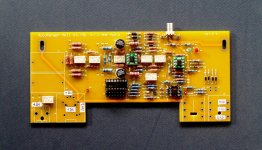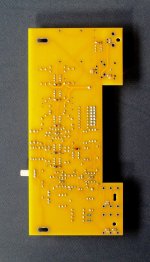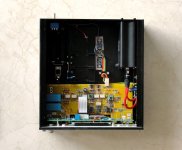I recently completed assembling an Autoranger kit. I had an initial problem getting it working which turned out to be the LTC1968 chip not making connection on some pins. It seems to work OK now, properly autoranging when different voltages are applied - but what I am noticing is that Vi will stay at whatever voltage it peeked at...as shown in the image below all connections have been removed but it's still showing 20v input. Occasionally it does change attenuation and goes back to near 0 after input is removed or turned off - but usually it stays anywhere between 0 and whatever value it peeked at. If I press hold and manually change the attenuation to +18dB it goes back down to near 0, but doing this each time is a bit of a hassle. I asked my friend and he said his does not do this so I thought I would ask here if this is how it is supposed to work?

Hello all,
Always looking to improve my test gear in the pursuit of excellence. Wondering if any AutoRanger II users have compared a AD797 opamp vs. a NE5534 for op-amp U3 AND taken measurements to evaluate any performance improvements? If so, would love to hear your findings.
Not wanting to shell out $20 for a AD797 only to find out there is no measurable improvement in performance.
I did find that changing the dual op-amp U4 from a LM4562 to a OPA1656 (on SOIC-DIP adapter) lowered both the noise floor and THD at +18dB gain by 0.5dB each. Not earthshaking, but then I already had a 1656 mounted on a DIP adapter in stock to try out, so cost in trying it out.
Thanks, Mike
Always looking to improve my test gear in the pursuit of excellence. Wondering if any AutoRanger II users have compared a AD797 opamp vs. a NE5534 for op-amp U3 AND taken measurements to evaluate any performance improvements? If so, would love to hear your findings.
Not wanting to shell out $20 for a AD797 only to find out there is no measurable improvement in performance.
I did find that changing the dual op-amp U4 from a LM4562 to a OPA1656 (on SOIC-DIP adapter) lowered both the noise floor and THD at +18dB gain by 0.5dB each. Not earthshaking, but then I already had a 1656 mounted on a DIP adapter in stock to try out, so cost in trying it out.
Thanks, Mike
The OPA1656 is truly a remarkable op amp, especially since it is a CMOS op amp. There is one caveat to be aware of that is not surprizing for a CMOS device. It has a high 1/f noise frequency. When they brag on noise performance they state the noise at 10 kHz. For audio instrumentation, look carefully at the noise curves between 10 Hz and 1 kHz.
Cheers,
Bob
Cheers,
Bob
Good point Bob. Luckily I don't pay much mind to what's below 1kHz on the RTA as I test at 1kHz and 10kHz most of the time (Victor oscillators). But out of curiosity I will take another look at the noise floors between the LM4562 and OPA1656 in the sub-1kHz region.look carefully at the noise curves between 10 Hz and 1 kHz.
For any interested, I compared using the AD797 to the NE5534 opamp for U3 in the AutoRanger II and found no measurable difference in my setup.
(Victor Oscillator 1kHz, modified EMU 0404USB soundcard, REW software). So I put the NE5534 back in and pulled the extra 47pF cap (C2) back out.
So now I know. Maybe others with a setup having a lower noise floor might find different results.
THD for 1kHz was unchanged at -120dB
Noise N (20-20kHz) unchanged at -130dBu at 0dB attenuation.
Noise floor density (en) unchanged at 56nV/rt-Hz at 1kHz.
(Victor Oscillator 1kHz, modified EMU 0404USB soundcard, REW software). So I put the NE5534 back in and pulled the extra 47pF cap (C2) back out.
So now I know. Maybe others with a setup having a lower noise floor might find different results.
THD for 1kHz was unchanged at -120dB
Noise N (20-20kHz) unchanged at -130dBu at 0dB attenuation.
Noise floor density (en) unchanged at 56nV/rt-Hz at 1kHz.
Unfortunately the OPA1656 in U4 in my AutoRanger II died an untimely death on one of its channels (pins 5-7). Since there were no signs of foul play (ie damaging signals applied to the AutoRanger inputs) I suspect that the OPA1656 is not stable in that application, at least on that channel.The OPA1656 is truly a remarkable op amp, especially since it is a CMOS op amp. There is one caveat to be aware of that is not surprizing for a CMOS device. It has a high 1/f noise frequency. When they brag on noise performance they state the noise at 10 kHz. For audio instrumentation, look carefully at the noise curves between 10 Hz and 1 kHz.
Cheers,
Bob
I reverted back to using a tried and true LM4562 for U4, not wanting to sacrifice any more of my OPA1656 stash sorting out the issue. Just FYI at this point.
A couple of years ago I bought an AR 3.19 kit and now is the time to finish the build. I did assemble the kit time ago, but did a couple of stupid mistakes which burned U3 (and possibly U4).
The recommended U3 part (ADA4610-2) is now on backorder at Mouser and I'm looking for a suitable substitute. Any suggestions?
Thanks,
Nic
The recommended U3 part (ADA4610-2) is now on backorder at Mouser and I'm looking for a suitable substitute. Any suggestions?
Thanks,
Nic
Seems there are no photos of V3.19b, so here it comes.
I am only using balanced output to drive a E1AD ADC via an OPA1622, both inside the same box.
So no output connectors.
Battery power for both 5V and +/-12V with post regulators.
Patrick
.
I am only using balanced output to drive a E1AD ADC via an OPA1622, both inside the same box.
So no output connectors.
Battery power for both 5V and +/-12V with post regulators.
Patrick
.
Attachments
Rear panel is nothing other than a toggle switch for power and an opening for USB-C output.
For the buffer, please read the details in Pavel's thread :
https://www.audiosciencereview.com/...-e1da-cosmos-adc-as-a-measuring-system.34723/
Patrick
For the buffer, please read the details in Pavel's thread :
https://www.audiosciencereview.com/...-e1da-cosmos-adc-as-a-measuring-system.34723/
Patrick
Thank you Patrick.
Soldering the output of AR to the buffer and then to the E1DA Cosmos ADC is much better than using male-female plugs.
Interconnects is a pain in terms of consistency in registering low levels of distortion.
I hope you'll achieve the same or better measurements as Pavel.
With my EMU 0404 soundcard (AK5385A ADC, AK3996VF DAC), Jan's AR seems transparent (see attachments, settings are close to Pavel's.
Please keep us posted with some measurement screenshots of your test set up
George
Soldering the output of AR to the buffer and then to the E1DA Cosmos ADC is much better than using male-female plugs.
Interconnects is a pain in terms of consistency in registering low levels of distortion.
I hope you'll achieve the same or better measurements as Pavel.
With my EMU 0404 soundcard (AK5385A ADC, AK3996VF DAC), Jan's AR seems transparent (see attachments, settings are close to Pavel's.
Please keep us posted with some measurement screenshots of your test set up
George
Attachments
-
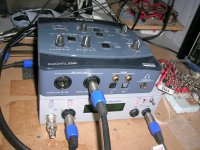 (0) EMU 0404+AR.JPG631.5 KB · Views: 127
(0) EMU 0404+AR.JPG631.5 KB · Views: 127 -
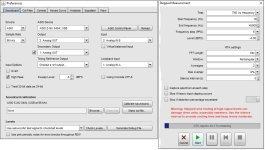 (1) settings.jpg113.9 KB · Views: 117
(1) settings.jpg113.9 KB · Views: 117 -
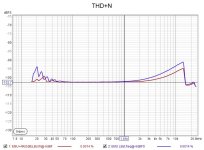 (2) THD+N.jpg109.8 KB · Views: 108
(2) THD+N.jpg109.8 KB · Views: 108 -
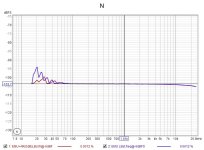 (3) N.jpg105.8 KB · Views: 94
(3) N.jpg105.8 KB · Views: 94 -
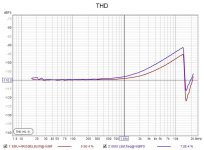 (4) THD.jpg110.2 KB · Views: 90
(4) THD.jpg110.2 KB · Views: 90 -
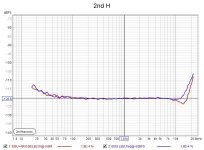 (5) 2nd H.jpg108.4 KB · Views: 89
(5) 2nd H.jpg108.4 KB · Views: 89 -
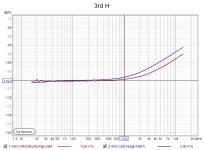 (6) 3rd H.jpg108.6 KB · Views: 87
(6) 3rd H.jpg108.6 KB · Views: 87 -
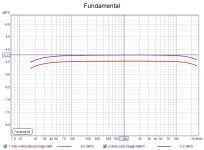 (7) Fundamental.jpg101.3 KB · Views: 79
(7) Fundamental.jpg101.3 KB · Views: 79 -
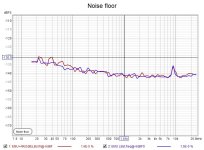 (8) Noise floor.jpg112 KB · Views: 86
(8) Noise floor.jpg112 KB · Views: 86 -
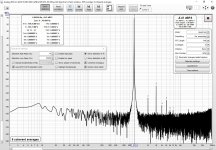 (9) 1kHz FFT.jpg300.9 KB · Views: 121
(9) 1kHz FFT.jpg300.9 KB · Views: 121
As requested, a FFT of the Viktor oscillator in single ended mode, through the AR, to E1DA.

Pretty sure those harmonics come from the opamps (OPA1656 + OPA1622) as the Viktor (latest version) is below -150dB.
So we can measure down to -120dB reliably.

Patrick
Pretty sure those harmonics come from the opamps (OPA1656 + OPA1622) as the Viktor (latest version) is below -150dB.
So we can measure down to -120dB reliably.
Patrick
- Home
- Design & Build
- Equipment & Tools
- Autoranger for soundcards
